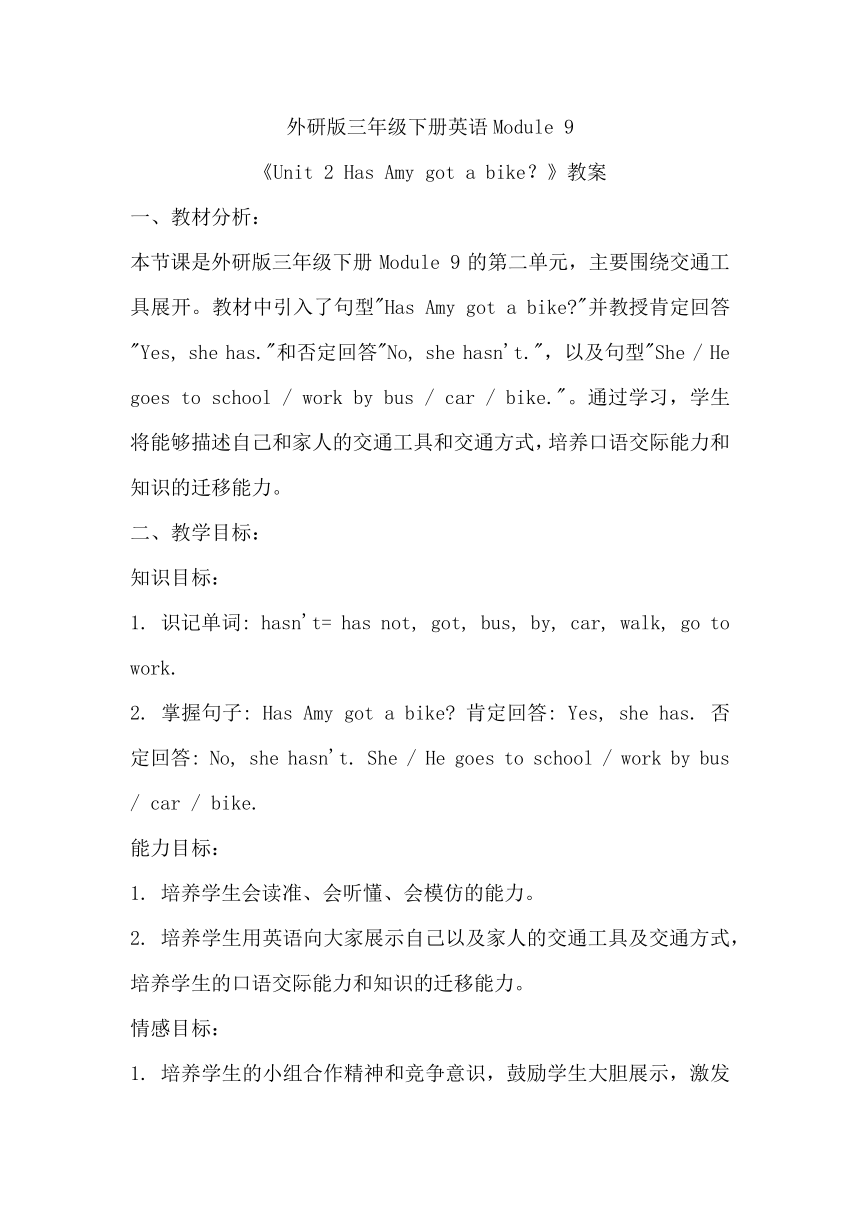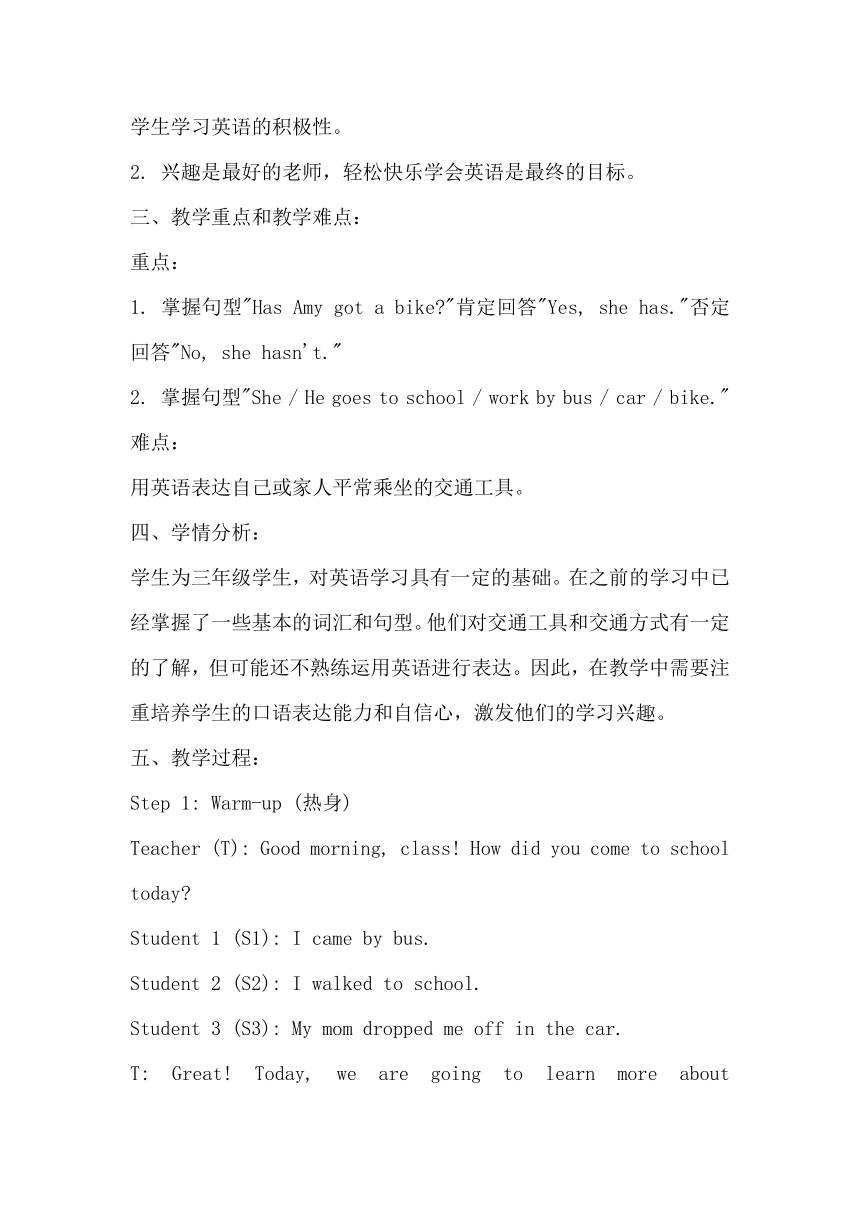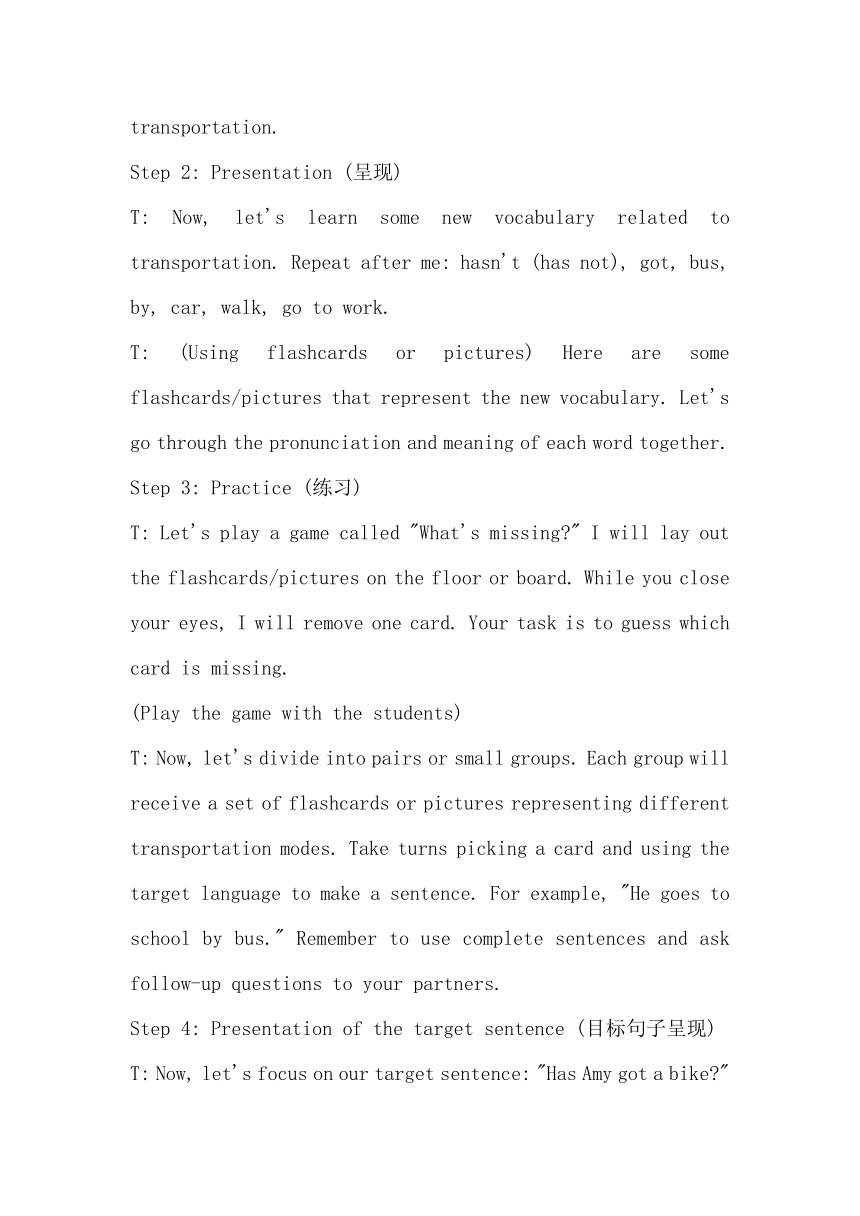Module 9 Unit 2 Has Amy got a bike?教案
文档属性
| 名称 | Module 9 Unit 2 Has Amy got a bike?教案 |

|
|
| 格式 | docx | ||
| 文件大小 | 13.7KB | ||
| 资源类型 | 教案 | ||
| 版本资源 | 外研版(三年级起点) | ||
| 科目 | 英语 | ||
| 更新时间 | 2024-02-05 08:23:58 | ||
图片预览



文档简介
外研版三年级下册英语Module 9
《Unit 2 Has Amy got a bike?》教案
一、教材分析:
本节课是外研版三年级下册Module 9的第二单元,主要围绕交通工具展开。教材中引入了句型"Has Amy got a bike "并教授肯定回答"Yes, she has."和否定回答"No, she hasn't.",以及句型"She / He goes to school / work by bus / car / bike."。通过学习,学生将能够描述自己和家人的交通工具和交通方式,培养口语交际能力和知识的迁移能力。
二、教学目标:
知识目标:
1. 识记单词: hasn't= has not, got, bus, by, car, walk, go to work.
2. 掌握句子: Has Amy got a bike 肯定回答: Yes, she has. 否定回答: No, she hasn't. She / He goes to school / work by bus / car / bike.
能力目标:
1. 培养学生会读准、会听懂、会模仿的能力。
2. 培养学生用英语向大家展示自己以及家人的交通工具及交通方式,培养学生的口语交际能力和知识的迁移能力。
情感目标:
1. 培养学生的小组合作精神和竞争意识,鼓励学生大胆展示,激发学生学习英语的积极性。
2. 兴趣是最好的老师,轻松快乐学会英语是最终的目标。
三、教学重点和教学难点:
重点:
1. 掌握句型"Has Amy got a bike "肯定回答"Yes, she has."否定回答"No, she hasn't."
2. 掌握句型"She / He goes to school / work by bus / car / bike."
难点:
用英语表达自己或家人平常乘坐的交通工具。
四、学情分析:
学生为三年级学生,对英语学习具有一定的基础。在之前的学习中已经掌握了一些基本的词汇和句型。他们对交通工具和交通方式有一定的了解,但可能还不熟练运用英语进行表达。因此,在教学中需要注重培养学生的口语表达能力和自信心,激发他们的学习兴趣。
五、教学过程:
Step 1: Warm-up (热身)
Teacher (T): Good morning, class! How did you come to school today
Student 1 (S1): I came by bus.
Student 2 (S2): I walked to school.
Student 3 (S3): My mom dropped me off in the car.
T: Great! Today, we are going to learn more about transportation.
Step 2: Presentation (呈现)
T: Now, let's learn some new vocabulary related to transportation. Repeat after me: hasn't (has not), got, bus, by, car, walk, go to work.
T: (Using flashcards or pictures) Here are some flashcards/pictures that represent the new vocabulary. Let's go through the pronunciation and meaning of each word together.
Step 3: Practice (练习)
T: Let's play a game called "What's missing " I will lay out the flashcards/pictures on the floor or board. While you close your eyes, I will remove one card. Your task is to guess which card is missing.
(Play the game with the students)
T: Now, let's divide into pairs or small groups. Each group will receive a set of flashcards or pictures representing different transportation modes. Take turns picking a card and using the target language to make a sentence. For example, "He goes to school by bus." Remember to use complete sentences and ask follow-up questions to your partners.
Step 4: Presentation of the target sentence (目标句子呈现)
T: Now, let's focus on our target sentence: "Has Amy got a bike " Repeat after me.
(Students repeat after the teacher)
T: This sentence is asking if Amy owns a bike. The appropriate responses are "Yes, she has" or "No, she hasn't." Let's practice the pronunciation and intonation of the target sentence and its responses.
(Practice pronunciation and intonation with the students)
T: Now, in pairs, take turns asking and answering the question using different names and transportation modes.
Step 5: Role-play (角色扮演)
T: Let's continue practicing the target sentence through role-play. Divide into pairs or small groups. One student will play the role of Amy, and the other will be her classmate. Use the target sentence to have a conversation. For example:
Student A: Has Amy got a bike
Student B (playing Amy): Yes, she has.
Student A: What about you Have you got a bike
Student B: No, I haven't. I go to school by bus.
Step 6: Group presentation (小组展示)
T: Now, let's work in small groups. Each group will create a short presentation about themselves and their family members' transportation modes. Use the target language and include questions and answers in your presentation. Take turns presenting your work to the class.
Step 7: Consolidation and extension (巩固和拓展)
T: Let's play a game called "Find the transportation mode." I will give each student a card with a transportation mode written on it. Your task is to find your partner who has the matching transportation mode.
T: Now, let's have a class discussion about different transportation modes and their advantages and disadvantages. Share your thoughts and experiences with the class.
T: For homework, I would like you to write a short paragraph about your own transportation mode or your family members' transportation modes. Use the target language and be as detailed as possible.
六、板书设计:
Has Amy got a bike
Yes, she has.
No, she hasn't.
She / He goes to school / work by bus / car / bike.
七、教学反思:
本节课通过引入新的句型和词汇,让学生学会描述交通工具和交通方式。在教学过程中,我采用了多种互动方式,如游戏、角色扮演和小组展示,激发了学生的学习兴趣。学生在小组合作中积极参与,能够用英语与他人进行简单的交流。然而,在后续的教学中,可以加入更多的口语练习和实际应用活动,以进一步巩固学生的学习成果。同时,需要关注学生的学习进度,根据实际情况调整教学内容和难度,确保每个学生都能够参与到教学活动中来。
《Unit 2 Has Amy got a bike?》教案
一、教材分析:
本节课是外研版三年级下册Module 9的第二单元,主要围绕交通工具展开。教材中引入了句型"Has Amy got a bike "并教授肯定回答"Yes, she has."和否定回答"No, she hasn't.",以及句型"She / He goes to school / work by bus / car / bike."。通过学习,学生将能够描述自己和家人的交通工具和交通方式,培养口语交际能力和知识的迁移能力。
二、教学目标:
知识目标:
1. 识记单词: hasn't= has not, got, bus, by, car, walk, go to work.
2. 掌握句子: Has Amy got a bike 肯定回答: Yes, she has. 否定回答: No, she hasn't. She / He goes to school / work by bus / car / bike.
能力目标:
1. 培养学生会读准、会听懂、会模仿的能力。
2. 培养学生用英语向大家展示自己以及家人的交通工具及交通方式,培养学生的口语交际能力和知识的迁移能力。
情感目标:
1. 培养学生的小组合作精神和竞争意识,鼓励学生大胆展示,激发学生学习英语的积极性。
2. 兴趣是最好的老师,轻松快乐学会英语是最终的目标。
三、教学重点和教学难点:
重点:
1. 掌握句型"Has Amy got a bike "肯定回答"Yes, she has."否定回答"No, she hasn't."
2. 掌握句型"She / He goes to school / work by bus / car / bike."
难点:
用英语表达自己或家人平常乘坐的交通工具。
四、学情分析:
学生为三年级学生,对英语学习具有一定的基础。在之前的学习中已经掌握了一些基本的词汇和句型。他们对交通工具和交通方式有一定的了解,但可能还不熟练运用英语进行表达。因此,在教学中需要注重培养学生的口语表达能力和自信心,激发他们的学习兴趣。
五、教学过程:
Step 1: Warm-up (热身)
Teacher (T): Good morning, class! How did you come to school today
Student 1 (S1): I came by bus.
Student 2 (S2): I walked to school.
Student 3 (S3): My mom dropped me off in the car.
T: Great! Today, we are going to learn more about transportation.
Step 2: Presentation (呈现)
T: Now, let's learn some new vocabulary related to transportation. Repeat after me: hasn't (has not), got, bus, by, car, walk, go to work.
T: (Using flashcards or pictures) Here are some flashcards/pictures that represent the new vocabulary. Let's go through the pronunciation and meaning of each word together.
Step 3: Practice (练习)
T: Let's play a game called "What's missing " I will lay out the flashcards/pictures on the floor or board. While you close your eyes, I will remove one card. Your task is to guess which card is missing.
(Play the game with the students)
T: Now, let's divide into pairs or small groups. Each group will receive a set of flashcards or pictures representing different transportation modes. Take turns picking a card and using the target language to make a sentence. For example, "He goes to school by bus." Remember to use complete sentences and ask follow-up questions to your partners.
Step 4: Presentation of the target sentence (目标句子呈现)
T: Now, let's focus on our target sentence: "Has Amy got a bike " Repeat after me.
(Students repeat after the teacher)
T: This sentence is asking if Amy owns a bike. The appropriate responses are "Yes, she has" or "No, she hasn't." Let's practice the pronunciation and intonation of the target sentence and its responses.
(Practice pronunciation and intonation with the students)
T: Now, in pairs, take turns asking and answering the question using different names and transportation modes.
Step 5: Role-play (角色扮演)
T: Let's continue practicing the target sentence through role-play. Divide into pairs or small groups. One student will play the role of Amy, and the other will be her classmate. Use the target sentence to have a conversation. For example:
Student A: Has Amy got a bike
Student B (playing Amy): Yes, she has.
Student A: What about you Have you got a bike
Student B: No, I haven't. I go to school by bus.
Step 6: Group presentation (小组展示)
T: Now, let's work in small groups. Each group will create a short presentation about themselves and their family members' transportation modes. Use the target language and include questions and answers in your presentation. Take turns presenting your work to the class.
Step 7: Consolidation and extension (巩固和拓展)
T: Let's play a game called "Find the transportation mode." I will give each student a card with a transportation mode written on it. Your task is to find your partner who has the matching transportation mode.
T: Now, let's have a class discussion about different transportation modes and their advantages and disadvantages. Share your thoughts and experiences with the class.
T: For homework, I would like you to write a short paragraph about your own transportation mode or your family members' transportation modes. Use the target language and be as detailed as possible.
六、板书设计:
Has Amy got a bike
Yes, she has.
No, she hasn't.
She / He goes to school / work by bus / car / bike.
七、教学反思:
本节课通过引入新的句型和词汇,让学生学会描述交通工具和交通方式。在教学过程中,我采用了多种互动方式,如游戏、角色扮演和小组展示,激发了学生的学习兴趣。学生在小组合作中积极参与,能够用英语与他人进行简单的交流。然而,在后续的教学中,可以加入更多的口语练习和实际应用活动,以进一步巩固学生的学习成果。同时,需要关注学生的学习进度,根据实际情况调整教学内容和难度,确保每个学生都能够参与到教学活动中来。
同课章节目录
- Module 1
- Unit 1 It's the ABC song.
- Unit 2 My favourite colour is yellow.
- Module 2
- Unit 1 They are monkeys.
- Unit 2 The man is short.
- Module 3
- Unit 1 I like football.
- Unit 2 I don't like riding my bike.
- Module 4
- Unit 1 Do you like meat?
- Unit 2 Does Lingling like oranges?
- Module 5
- Unit 1 She goes to school on Mondays.
- Unit 2 Does your mum go to work on Saturdays?
- Module 6
- Unit 1 What do you do on Sundays?
- Unit 2 What does Lingling have at school?
- Module 7
- Unit 1 We fly kites in spring.
- Unit 2 It's warm today.
- Module 8
- Unit 1 It's on your desk.
- Unit 2 Daming flies a kite in the park.
- Module 9
- Unit 1 I've got a new book.
- Unit 2 Has Amy got a bike?
- Review Module
- Unit 1
- Unit 2
- Module 10
- Unit 1 Here's a red hat.
- Unit 2 She's got an orange sweater.
